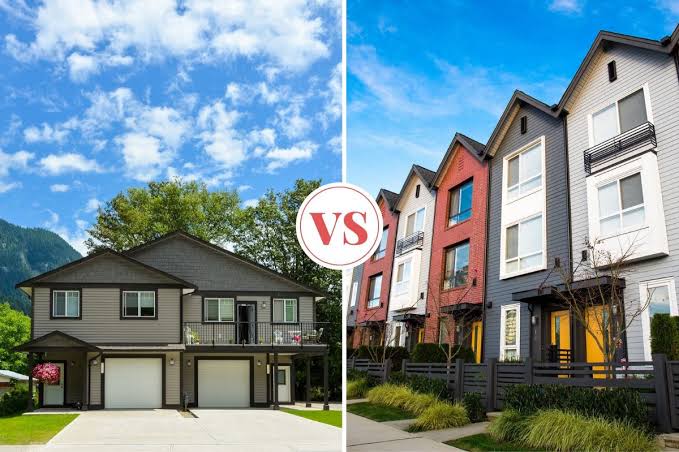Money Mind: Differences Between Single-Family And Multi-Family Properties

When contemplating the idea of purchasing a rental property, you may be tempted to choose between single-family or multifamily dwellings. But, as with all decisions in life – choosing between these options can be difficult! Ultimately, there exists no perfect choice; it entirely depends on what kind of lifestyle and additional income you desire.
Table of Contents
Single Family Vs Multi-Family
Single-family properties are residential dwellings that are occupied by one family at a time. These properties usually consist of a house and a yard, as well as any additional structures on the property such as a garage, shed, or outdoor living space. Single-family properties are usually owner-occupied, though they may be rented out as well.
Multi-family properties are residential dwellings that are occupied by multiple families at a time. These properties usually consist of a building or complex containing multiple apartments or dwellings, each of which is typically occupied by a separate family. These dwellings may be owner-occupied, but they are more commonly rented out to tenants. Multi-family properties are more common in urban areas, but can be found in suburban and rural areas as well.
Financing Options
DSCR loans (Debt Service Coverage Ratio) are loans that are designed to ensure that the property’s income is sufficient enough to cover all the loan payments. This ratio is calculated by dividing the property’s net operating income by the total debt service. It is important to have a good DSCR ratio when seeking a loan in order to have a better chance of getting approved.
Multifamily loans are loans specifically designed for multifamily properties. These loans are typically larger than single-family loans and are also subject to higher interest rates. Multifamily loans are typically used for the purchase or refinance of multifamily properties, such as apartment buildings or large complexes.
Bridge loans are short-term loans that are used to finance an acquisition or refinance before long-term financing is secured. Bridge loans are often used when the borrower wants to take advantage of an opportunity quickly, but does not have the time to secure long-term financing.
Hard money loans are short-term loans provided by private lenders. These loans are typically used when the borrower cannot qualify for traditional financing or when the loan needs to be approved quickly. Hard money loans are usually more expensive than traditional loans, but can be secured quickly.
Portfolio loans are provided by banks or other financial institutions for the purchase or refinance of real estate properties. Unlike other types of loans, portfolio loans are not sold on the secondary market so they are more flexible and can be tailored to the borrower’s specific needs.
Tax Considerations
Single-family properties typically require the owner to pay income tax on any profit made from the property. This profit is calculated from the difference between the purchase price of the property and the sale price. The owner may also have to pay capital gains tax on any profits made from the sale of the property. Any expenses related to the property such as repairs, insurance, and utilities are tax deductible.
Multi-family properties are subject to the same income tax laws as single-family properties. However, due to the larger size of the property, the deductions can be more substantial. Additionally, multi-family properties may qualify for certain tax breaks such as depreciation deductions, which can reduce the total amount of taxes owed. Additionally, any expenses related to the multi-family property that are not related to the rental income may be tax deductible.
Benefits Of Purchasing Single-Family Rental Property
For starters, single-family homes are a financially sound investment choice. If you’re searching for an opportunity to diversify your portfolio, real estate can be an enticing proposition due to its stability and reliability over time (provided it remains in good shape).
Single-family rentals may also be advantageous if you seek a less complex property. This could prove beneficial when renting out your property with multiple tenants; as no special negotiations will be required!
Benefits Of Purchasing Multi-Family Rental Property
Multi-family rental properties offer a range of financial benefits that can make them an attractive and lucrative investment. Multi-family properties typically generate higher rental income than single-family homes due to the increased number of units. This higher rental income can help to offset the costs of managing and maintaining the property.
Multi-family properties may also be eligible for certain tax breaks such as depreciation deductions, which can reduce the total amount of taxes owed. These properties may also provide economies of scale when it comes to expenses such as insurance and utilities. As the number of units increases, so too can the potential for a higher income.
Being a rental property investor can be a lucrative and rewarding venture. With the right strategy and proper research, investors can enjoy the benefits of owning a property, such as long-term appreciation, rental income, and tax deductions. Whether you decide on a single-family or multi-family property, the key is to have a plan that accounts for all aspects of the investment, such as financing, taxes, and maintenance. By taking the time to understand the market and create a well-developed plan, investors can be successful in their rental property investments.






